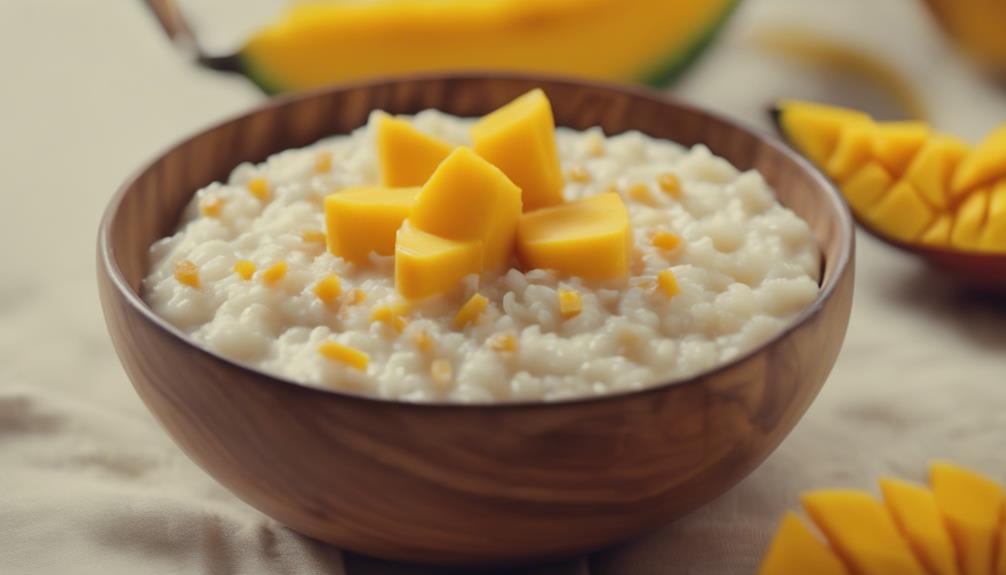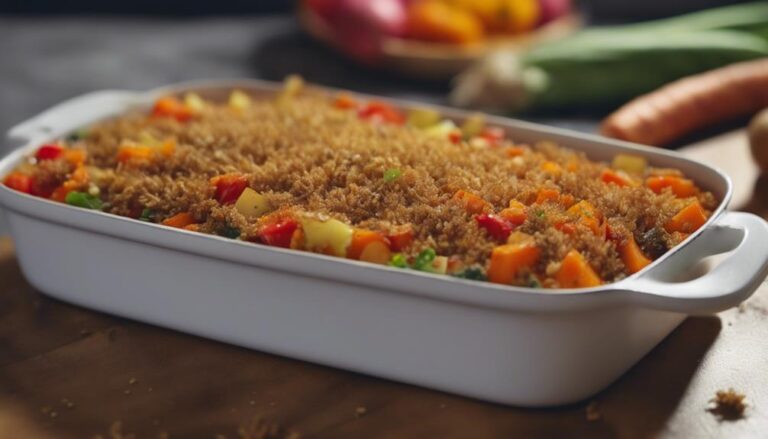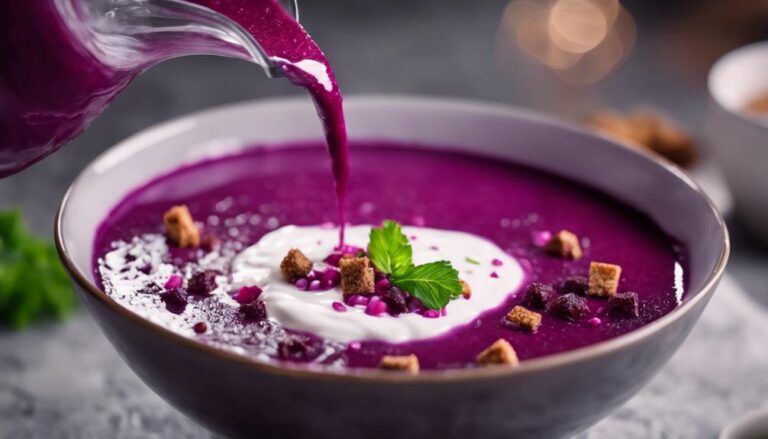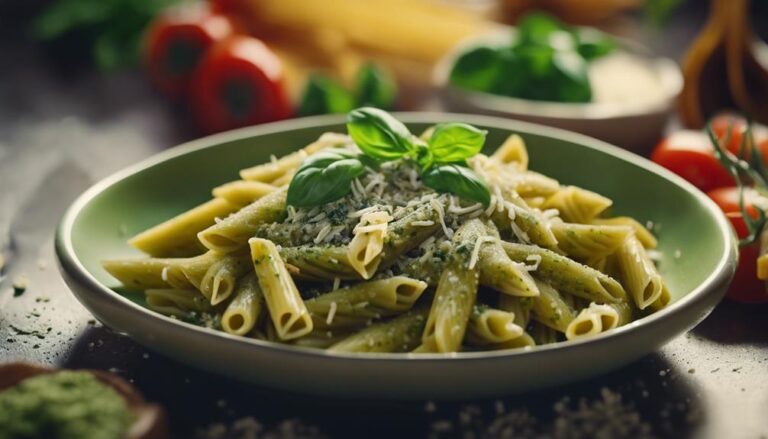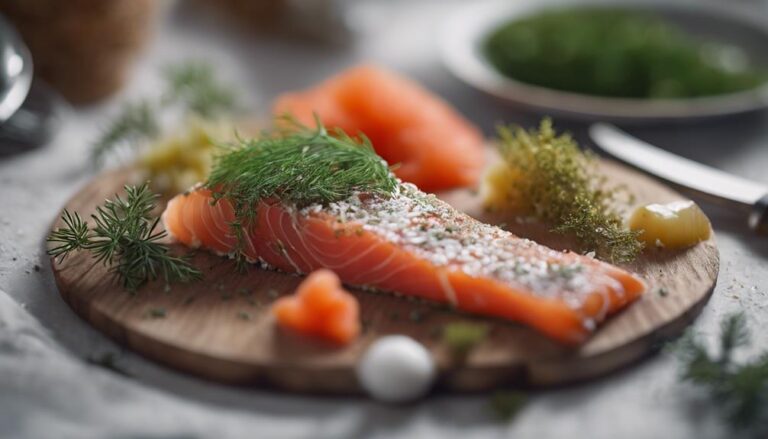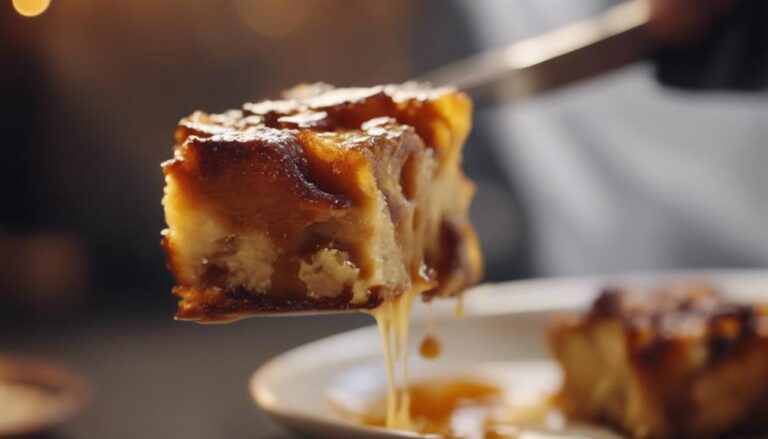Sous Vide Coconut Rice Pudding With Mango
Discover a flavorful blend with Sous Vide Coconut Rice Pudding with Mango. Enjoy the fusion of creamy coconut and tropical mango for a unique dessert experience. Steaming glutinous rice with coconut milk guarantees a rich, creamy texture. Consider ripe, fragrant mangoes for the perfect sweetness balance. Opt for alternatives like almond or cashew milk for a twist. Enhance your culinary journey with this innovative dish that marries traditional flavors with modern techniques. Uncover the art of achieving a harmonious balance of flavors and textures in a delightful way.
What You Will Learn Here
- Sous vide method enhances creaminess and flavor infusion.
- Precision cooking elevates traditional Thai Sticky Rice dessert.
- Mango selection impacts sweetness balance in the dish.
- Experiment with milk substitutes like almond or cashew milk.
- Textural contrast with crunchy mung beans adds delight.
Culinary Roots in Southeast Asia
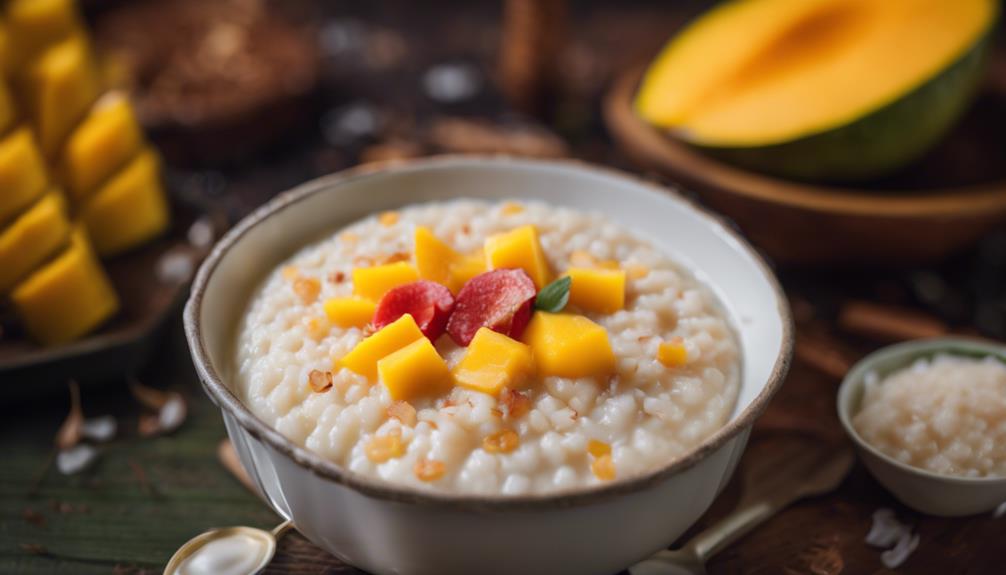
Glutinous rice, coconut milk, mangoes, and basil are integral ingredients in Southeast Asian cuisine, contributing to the region's vibrant flavor profile.
Traditional cooking techniques in Southeast Asia, like simmering rice in coconut milk, showcase the rich culinary heritage of the region.
The fusion of these traditional flavors with modern culinary practices creates dishes that honor the roots of Southeast Asian cuisine while embracing innovation.
Southeast Asian Flavor Profile
Originating from Southeast Asia, the culinary roots of coconut rice pudding with mango exemplify the region's affinity for blending sweet and tropical flavors. Sticky rice, a staple in Southeast Asian cuisine, provides a chewy texture ideal for desserts.
Mangoes, with their juicy sweetness, are commonly used in Southeast Asian sweets, complementing the creaminess of coconut. The combination of coconut, sticky rice, and mango reflects the vibrant and tropical culinary traditions of the region.
In Southeast Asia, the harmonious fusion of coconut, mango, and sticky rice creates a delightful balance of flavors, showcasing the region's expertise in creating desserts that are both comforting and exotic. This flavor profile captures the essence of Southeast Asian cuisine, where each ingredient plays an essential role in crafting a harmonious and delectable dish.
Traditional Cooking Techniques
Traditional techniques in Southeast Asian cuisine involve steaming glutinous rice with coconut milk to create a creamy and flavorful dessert. The process of soaking the glutinous rice before steaming is a common practice in Southeast Asian cooking, ensuring the rice reaches the desired texture.
Coconut milk, a key ingredient in many Southeast Asian desserts, adds richness and enhances the overall flavor profile. The combination of glutinous rice and coconut milk results in a velvety pudding that's both comforting and indulgent.
These traditional methods highlight the importance of using natural ingredients and time-honored techniques to achieve a harmonious balance of flavors. By respecting these culinary roots, you can experience the authentic taste of Southeast Asia in every spoonful of coconut rice pudding.
Fusion With Modern Cuisine
Embracing the culinary heritage of Southeast Asia, the fusion of modern cuisine techniques with traditional flavors in Sous Vide Coconut Rice Pudding with Mango showcases innovation and creativity in the kitchen.
This dish expertly combines the richness of Thai Sticky Rice with the modern precision of sous vide cooking, resulting in a dessert that's both creamy and perfectly textured.
By infusing the coconut rice with flavors through the sous vide method, the dish achieves a level of refinement and consistency that elevates it beyond traditional boundaries.
The marriage of culinary roots from Southeast Asia with contemporary cooking approaches not only highlights the evolution of cuisine but also offers a delightful culinary experience that fuses tradition with innovation.
Coconut Milk Substitution Options
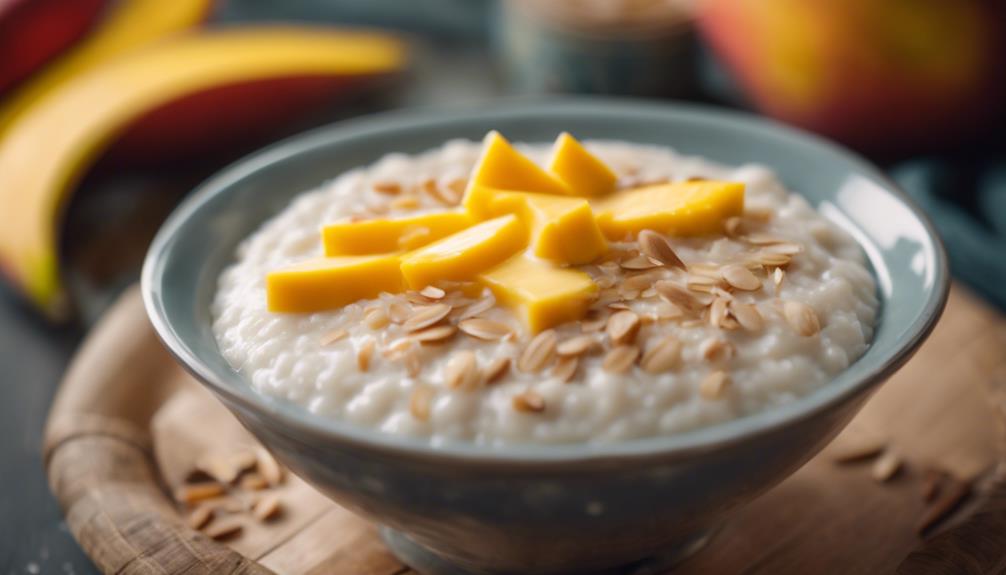
Substitute coconut milk in your coconut rice pudding recipe with almond milk for a lighter alternative that still offers a creamy texture. If you're looking to experiment further, consider these options:
- Almond Milk: A great alternative to coconut milk, almond milk provides a lighter texture while maintaining creaminess. It offers a slightly nutty flavor that complements the rice pudding well.
- Cashew Milk: For a twist in flavor, try using cashew milk instead of coconut milk. The nutty undertones of cashews can add a unique taste to your rice pudding, enhancing its overall profile.
- Coconut Cream: If you prefer a richer consistency, coconut cream can be a suitable replacement for coconut milk. It will intensify the coconut flavor in the pudding while providing a velvety mouthfeel.
Experimenting with different milk substitutes can offer exciting variations to your coconut rice pudding, catering to different preferences and dietary needs.
Thai Mango Sticky Rice
To make the perfect Thai Mango Sticky Rice, start by soaking glutinous rice in cold water to achieve the desired sticky texture.
Toasting mung beans until crispy adds a delightful crunch to the dish.
Enhance the traditional flavors by preparing a salted coconut sauce to accompany the sweet mango and sticky rice.
Sticky Rice With Sweet Mango
For achieving the perfect texture and flavor in your Thai Mango Sticky Rice, proper preparation techniques such as soaking glutinous rice and steaming it are essential steps to follow. Here's a guide to creating a delightful Sticky Rice with Sweet Mango:
- Soak Glutinous Rice: Make sure to soak the glutinous rice for a minimum of 4 hours to achieve the desired texture and consistency.
- Steam the Rice: Steaming the rice for around 30 minutes is vital in achieving the sticky and tender texture characteristic of this dish.
- Toast Mung Beans: Toast mung beans until they're crispy to add a delightful crunch and nutty flavor to your Sticky Rice with Sweet Mango.
Mango Sticky Rice Variations
When exploring Mango Sticky Rice variations, consider incorporating different types of mangoes to elevate the tropical sweetness of the dish. Here are some variations to enhance your Thai Mango Sticky Rice experience:
- Mango Selection: Experiment with different mango varieties like Ataulfo, Keitt, or Honey mangoes to discover unique flavor profiles that complement the coconut milk-infused glutinous rice.
- Coconut Milk Ratio: Adjust the amount of coconut milk used in the recipe to achieve your preferred level of creaminess and coconut flavor in the mango sticky rice.
- Toppings: Get creative with toppings such as crushed peanuts, shredded coconut, or a drizzle of coconut cream to add extra layers of texture and richness to your dessert.
Coconut Milk Infusion Method
Consider enhancing the tropical richness of your Thai Mango Sticky Rice by infusing coconut milk with a sous vide method for ideal flavor extraction and precise temperature control. When infusing coconut milk for sticky sweet rice:
- Start by combining coconut milk and sticky sweet rice in a sous vide bag.
- Seal the bag and set the sous vide machine to a temperature between 150-160°F.
- Let the mixture infuse for 1-2 hours to guarantee a rich and creamy coconut flavor permeates the rice thoroughly.
This method guarantees a consistent and intense coconut taste, creating a velvety texture for your Thai Mango Sticky Rice. The slow infusion process, coupled with sous vide precision, ensures the best possible flavor extraction and a delightful culinary experience.
Enhancing Mango Flavor Profile
Enhancing the mango flavor profile involves striking a delicate balance of sweetness that harmonizes with other ingredients. By pairing mango with complementary flavors like lime juice and chili powder, you can create a multifaceted taste experience.
Additionally, incorporating textural contrast through the use of diced, sliced, or mashed mango can elevate the overall enjoyment of the dessert.
Sweetness Balance in Mango
To enhance the flavor profile of mango, carefully selecting ripe varieties can greatly impact the overall sweetness of the dish. Mango sweetness varies among popular choices like Ataulfo, Kent, and Tommy Atkins, with ripe mangoes being sweeter due to the development of natural sugars as the fruit ripens.
Balancing the sweetness of mango with creamy coconut rice pudding creates a harmonious flavor combination. The acidity in mangoes can counterbalance the richness of the coconut milk, offering a revitalizing contrast in the dessert.
Peak sweetness in the dish is guaranteed by choosing perfectly ripe mangoes with a fragrant aroma and slight give when gently squeezed. Selecting the right mango variety will elevate the dish, providing a delightful and well-balanced sweetness to complement the coconut rice pudding.
Complementary Flavor Pairings
Enhance the mango flavor profile by carefully selecting complementary flavor pairings for the Sous Vide Coconut Rice Pudding. When serving Rice Pudding with Mango, consider pairing it with a sweet Auslese Riesling from Germany. This wine choice enhances the overall dining experience by harmonizing with the flavors of the coconut rice pudding and mango.
Auslese Riesling wines, known for their high sugar content in the grapes, complement the sweetness of the mango perfectly. The low alcohol content, balanced sweetness, acidity, and minerality of Riesling make it an ideal match for the dish. The sweetness and acidity of the mango are beautifully accentuated by the characteristics of the Auslese Riesling, creating a delightful culinary experience.
Textural Contrast With Mango
For an enchanting dining experience that enhances the mango flavor, consider incorporating a textural contrast with crunchy mung beans in your Sous Vide Coconut Rice Pudding. The sweet sticky rice, a staple in authentic Thai cuisine, provides a creamy base for the dish.
By toasting mung beans until crispy, you introduce a delightful textural element that contrasts beautifully with the softness of the rice pudding. This textural contrast not only adds a satisfying crunch but also elevates the overall sensory experience of the dessert.
When paired with the mango's natural sweetness, the crispy mung beans create a harmonious blend of flavors and textures, offering a delightful balance that will surely impress your guests.
Final Thoughts
In conclusion, incorporating the recommended methods guarantees a delicious and harmonious Sous Vide Coconut Rice Pudding With Mango. By following the steps of soaking glutinous rice, toasting mung beans, preparing the salted coconut sauce, and steaming the rice, you make sure that each component contributes to the overall taste and texture experience. The sticky, sweet coconut sauce plays a crucial role in enhancing the dessert's flavor profile, adding a perfect balance of sweetness and savory notes.
To further emphasize the importance of each step in creating this delightful dessert, let's break down the key elements in a table format to highlight their significance:
| Key Elements | Importance |
|---|---|
| Soaking Rice | Ensuring proper texture and consistency |
| Toasting Mung Beans | Adding a crunchy contrast to the pudding |
| Coconut Sauce | Enhancing flavor with sweet-savory notes |
| Steaming the Rice | Developing a sticky, creamy texture |
Frequently Asked Questions
Can You Use Coconut Milk Instead of Water When Cooking Rice?
Yes, you can use coconut milk instead of water when cooking rice. Substituting water with coconut milk in recipes enhances flavor profiles, creating a creamy texture and richer results. It adds depth, making it a flavorful alternative.
Why Does My Coconut Rice Come Out Mushy?
If your coconut rice turns mushy, it's probable due to excessive water absorption leading to the starch breaking down. Maintain heat control, modify liquid ratios, and contemplate flavor balance adjustments for an ideal rice texture.
How to Serve Coconut Rice?
When serving coconut rice, experiment with flavor combinations like tropical fruits and toasted coconut flakes. For presentation, garnish with fresh mango slices and a drizzle of salted coconut sauce. Consider serving suggestions like pairing with a sweet wine for a delightful experience.
Should Rice Be Washed Before Making Rice Pudding?
Before making rice pudding, washing rice is crucial. It removes excess starch for a smoother texture and guarantees cleanliness. This step impacts flavor, creating a consistent and appealing final product. Contrary to myths, washing rice enhances the overall quality.
Conclusion
To sum up, sous vide coconut rice pudding with mango offers a delightful fusion of Southeast Asian flavors.
By exploring different coconut milk substitution options and enhancing the mango flavor profile, this dish provides a unique twist on the traditional Thai mango sticky rice.
With the precise technique of sous vide cooking, the result is a creamy and flavorful dessert that's sure to impress your taste buds.
Give this recipe a try for a delicious and exotic treat.
